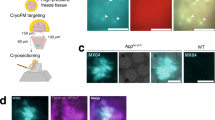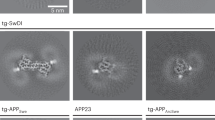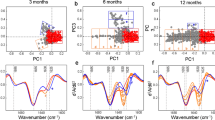Abstract
ALZHEIMER'S disease is the most common cause of progressive intellectual failure in aged humans. The filamentous brain lesions which define the disease occur within neurons (neurofibrillary tangles), in extracellular cerebral deposits (amyloid plaques) and in meningocerebral blood vessels (amyloid angiopathy)1,2. They are found in lesser numbers in the brains of virtually all old humans1. A protein with a relative molecular mass (Mr) of ∼4,000, designated amyloid β-protein or amyloid A4 protein, is the subunit of the vascular and plaque amyloid filaments in individuals with Alzheimer's disease3–5, normal ageing6 and trisomy 21 (Down's syndrome) 7. The amyloid β-protein is a small fragment of a membrane-associated glycoprotein8–13, encoded by a gene on human chromosome 21 which is telomeric to a genetic defect that causes at least some cases of familial Alzheimer's disease14,15. Until now, the pathological lesions of the disease have been found only in the brain, although reports of phenotypic abnormalities in non-neural tissues16–20 have suggested that Alzheimer's disease may be a widespread, systemic disorder. Here we report the detection of amyloid β-protein deposits in non-neural tissues and blood vessels of Alzheimer's disease patients, including skin, subcutaneous tissue and intestine. The protein was also present in non-neural tissues in a proportion of aged, normal subjects. Our findings indicate that a principal feature of the disease process is expressed subclinically in tissues other than brain. The occurrence of amyloid β- protein deposits in multiple tissues suggests that the protein may be produced locally in numerous organs or may, as in other human amyloidoses, be derived from a common circulating precursor. These observations affect the rationale for many experiments analysing the amyloid β-protein precursor and its messenger RNAs in Alzheimer's disease brain tissue and have major implications for the pathogenesis and treatment of the disease.
This is a preview of subscription content, access via your institution
Access options
Subscribe to this journal
Receive 51 print issues and online access
$199.00 per year
only $3.90 per issue
Buy this article
- Purchase on Springer Link
- Instant access to full article PDF
Prices may be subject to local taxes which are calculated during checkout
Similar content being viewed by others
References
Tomlinson, B. E. & Corsellis, J. A. N. in Greenfield' Neuropathology (eds Adams, J. H., Corsellis, J. A. N. & Duchen, L. W.) 951–1025 (Arnold, London, 1984).
Anderton, B. H. Nature 325, 658–659 (1987).
Glenner, G. G. & Wong, C. W. Biochem. biophys. Res. Commun. 120, 885–890 (1984).
Masters, C. L. et al. Proc. natn. Acad. Sci. U.S.A. 82, 4245–4249 (1985).
Selkoe, D. J., Abraham, C. R., Podlisny, M. B. & Duffy, L. K. J. Neurochem. 46, 1820–1834 (1986).
Coria, F., Castano, E. M. & Frangione, B. Am. J. Path. 129, 422–428 (1988).
Glenner, G. G. & Wong, C. W. Biochem. biophys. Res. Commun. 122, 1131–1135 (1984).
Kang, J. et al. Nature 325, 733–736 (1987).
Ponte, P. et al. Nature 331, 525–527 (1988).
Tanzi, R. E. et al. Nature 331, 528–530 (1988).
Kitaguchi, N., Takahashi, Y., Tokushima, Y., Shiojiri, S. & Ito, H. Nature 331, 530–532 (1988).
Selkoe, D. J. et al. Proc. natn. Acad. Sci. U.S.A. 85, 7341–7345 (1988).
Weidemann, A. et al. Cell 57, 115–126 (1989).
St. George-Hyslop, P. H. et al. Science 238, 664–666 (1987).
Goate, A. M. et al. Lancet 352–355 (1989).
Markesbery, W. R., Leung, P. K. & Butterfield, D. A. J. Neurol. Sci. 45, 323–330 (1980).
Peterson, C., Gibson, G. E. & Blass, J. P. N. Engl. J. Med. 312, 1063–1065 (1985).
Scudiero, D. A. et al. Mutat. Res. 159, 125–131 (1986).
Peterson, C. & Goldman, J. E. Proc. natn. Acad. Sci. U.S.A. 83, 2758–2762 (1986).
Zubenko, G. S., Wusylko, M., Cohen, B. M., Boller, F. & Teply, I. Science 238, 539–542 (1987).
Tagliavani, F., Giaccone, G., Frangione, B. & Bugiani, O. Neurosci. Lett. 93, 191–196 (1988).
Yamaguchi, H., Hirai, S., Morimatsu, M., Shoji, M. & Harigaya, Y. Acta Neuropath. 76, 541–549 (1988).
Mann, D. & Esiri, M. M. N. Engl. J. Med. 318, 789 (1988).
Joachim, C. L., Morris, J. & Selkoe, D. J. Am. J. Path. 135, 309–319 (1989).
Glenner, G. G. in Banbury Report: Biological Aspects of Alzheimer's Disease (ed. Katzman, R.) 137–144 (Cold Spring Harbor Laboratory, New York, 1983).
Selkoe, D. J. Neurobiol. Aging 7, 425–432 (1986).
Eikelenboom, P., & Stam, F. C. Acta Neuropath. 57, 2139–2142 (1982).
Abraham, C. R., Selkoe, D. J. & Potter, H. Cell 52, 487–501 (1988).
Coria, F. et al. Lab. Invest. 58, 454–458 (1988).
Hart, M. N. et al. Am. J. Path. 132, 167–172 (1988).
Joachim, C. L., Duffy, L. K., Morris, J. H. & Selkoe, D. J. Brain Res. 474, 100–111 (1988).
Selkoe, D. J., Bell, D. S., Podlisny, M. B., Price, D. L. & Cork, L. C. Science 235, 873–877 (1987).
Ihara, Y., Abraham, C. & Selkoe, D. J. Nature 304, 727–730 (1983).
Dahl, D. & Bignami, A. Brain Res. 57, 343–360 (1973).
Shirahama, T., Cohen, A. S. & Skinner, M. in Advances in Immunohistochemistry (ed. DeLellis, R. A.) 277–302 (Masson, New York, 1984).
Ju, S.-T., Skinner, M., Shirahama, T. & Cohen, A. S. Fedn Proc. 46, 1326 (1987).
Van Duinen, S. G. et al. Proc. natn. Acad. Sci. U.S.A. 84, 5991–5994 (1987).
Kitamoto, T., Ogomori, K., Tateishi, J. & Prusiner, S. B. Lab. Invest. 57, 230–236 (1987).
Blöndal, H., Guomundsson, G., Benedikz, E. & Johannesson, G. Alzheimer' Dis. Assoc. Dis. 2, 170 (1988).
Author information
Authors and Affiliations
Rights and permissions
About this article
Cite this article
Joachim, C., Mori, H. & Selkoe, D. Amyloid β-protein deposition in tissues other than brain in Alzheimer's disease. Nature 341, 226–230 (1989). https://doi.org/10.1038/341226a0
Received:
Accepted:
Issue Date:
DOI: https://doi.org/10.1038/341226a0
This article is cited by
-
Label-free detection and quantification of ultrafine particulate matter in lung and heart of mouse and evaluation of tissue injury
Particle and Fibre Toxicology (2022)
-
Disorders of the enteric nervous system — a holistic view
Nature Reviews Gastroenterology & Hepatology (2021)
-
Amyloid-Rich Pancreatic Neuroendocrine Tumors: a Potential Diagnostic Pitfall in Endoscopic Ultrasound–Guided Fine Needle Aspiration Cytology (EUS-FNAC)
Endocrine Pathology (2021)
-
Phosphorylated Tau protein in the myenteric plexus of the ileum and colon of normothermic rats and during synthetic torpor
Cell and Tissue Research (2021)
-
Peripheral clearance of brain-derived Aβ in Alzheimer's disease: pathophysiology and therapeutic perspectives
Translational Neurodegeneration (2020)
Comments
By submitting a comment you agree to abide by our Terms and Community Guidelines. If you find something abusive or that does not comply with our terms or guidelines please flag it as inappropriate.



